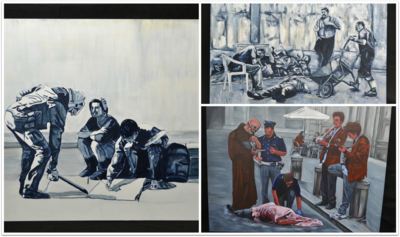On Saturday, January 18th at 11:00 am at PAN | Palazzo delle Arti Napoli Paolo Naldi's personal exhibition will be inaugurated. Theexhibition, titled "Strange Human Law", is edited by Massimo Sgroi and promotedby the Councillorship of Culture and Tourism of Naples.
Every day millions of people roam through the streetsthat bring them to nowhere. They are the streets of huge urban metropolis, ofthe suburbs, of the cities where humans run like crazed lemmings, towards thesocio ecological catastrophe of the third millennium. They are those who livethe agonies of non-places, of the monsters of the great conurbations deprivedof identities and histories; monsters where every fraction of a city ends upbeing another world, different from a story and a memory. The ethnocentricanxieties of the forced concentrations of ethnic groups, who are often distantfrom each other, cancel out any possibility of creating a world that has aproject and the dystopias of this existence can only create a mean evolution ofinequality. According to this point of view and considering the abominablesocio-urbanistic sense, it is possible to talk about "Blade Runner".The agony of Los Angeles inevitably influences Paris, London, Berlin, Milan, Rome, Naples and the dream of a peaceful society disappears, moreover it isreplaced by a relationship in which violence itself is the ratio of theindividual and collective rib. What isthe aim of art nowadays? Does it still make sense to look for a beauty evermore distant from its philosophical essence and increasingly linked to an emptycosmetic market? The answers concern in different ways the whole world ofculture and art. One of the most dramatically urgent problems of the entirenational territory, as for instance the major mafia organizations, becomesaccording to the collective imagination the new subjects of an Oscar movie. Forthis reason, it is a dangerous theme to be developed. Paolo Naldi considersthis experience to reread the vision of the contemporary and the explosivecontradictions of the third millennium. The cycles of his work are based on apainting lasts, without mediation, and showing extreme drift conflict of thestory of the new human form.
In Naldi's works, the agony of the metropolis becomesdark landscape on the surface of the canvas; his painting is sedimentation ofmeanings where the signifier is substantiated on the end wall of memories. AsJean Louis Weissberg states the common goal of contemporary art and of manyscientific disciplines is to fathom the image to break the status ofontological dependence from the object. It goes without saying that thecomputerization of it virtual, when it assumes the functions of the displayitself, is able to superimpose the two extremes of this paradigm: the image andthe object itself. People have always considered the mirror as the door thatseparates the stage of life from alterity. Nowadays, the computer screenrepresents the meeting point where these two things meet with each other, thearea in which the self and the self-other are simultaneously representing theinteraction and the hybridization of these different levels of reality. Theartwork is coincident; at least in its conceptual meaning with this kind ofview, it comes from the new way that the human being has to relate to the newform of reality. In any case, what identifies the membership of the work is theformal synthesis of the image; in "The street behind the wall", forexample, Paul Naldi operates the pruning between the different levels ofreality, superimposing them on each other to become a hard otherness visiblefrom both sides: the physical reality and the that of the media image.Similarly, "Civil Rules" serial, is a projection of a meaninglessworld in which the corporeal excess deprives of meaning the retrieval of anailing libido. Another example is the dark presence of death in "MedeaSyndrome", where the memory of our historical essence is lost in aperpetual and violent social conflict. According to Woody Guthrie the artist isin a dilemma: people represent his afflatus, his artistic sensibility is aphilter and at the end he gives back his product to people. The real questionis: What can we give back nowadays?
Critical text by Massimo Sgroi
Paolo Naldi, Neapolitanartist, was born in 1978.Since his childhood, the artist experienced a deeprelationship with art, moreover he began an intense training period. He wasmainly fond of Art and Humanities. Even though he received a degree ineconomics for international trade and exchange market, art suddenly became hisreal profession. Despite his artistic career in the underground panorama andbecause of his strong anti-cultural ideas, only in the last few years PaoloNaldi has approached to the art market and to exhibition spaces. His worksarouse the attention of important national and international art critics asMassimo Sgroi, John Thomas Spike, etc.
